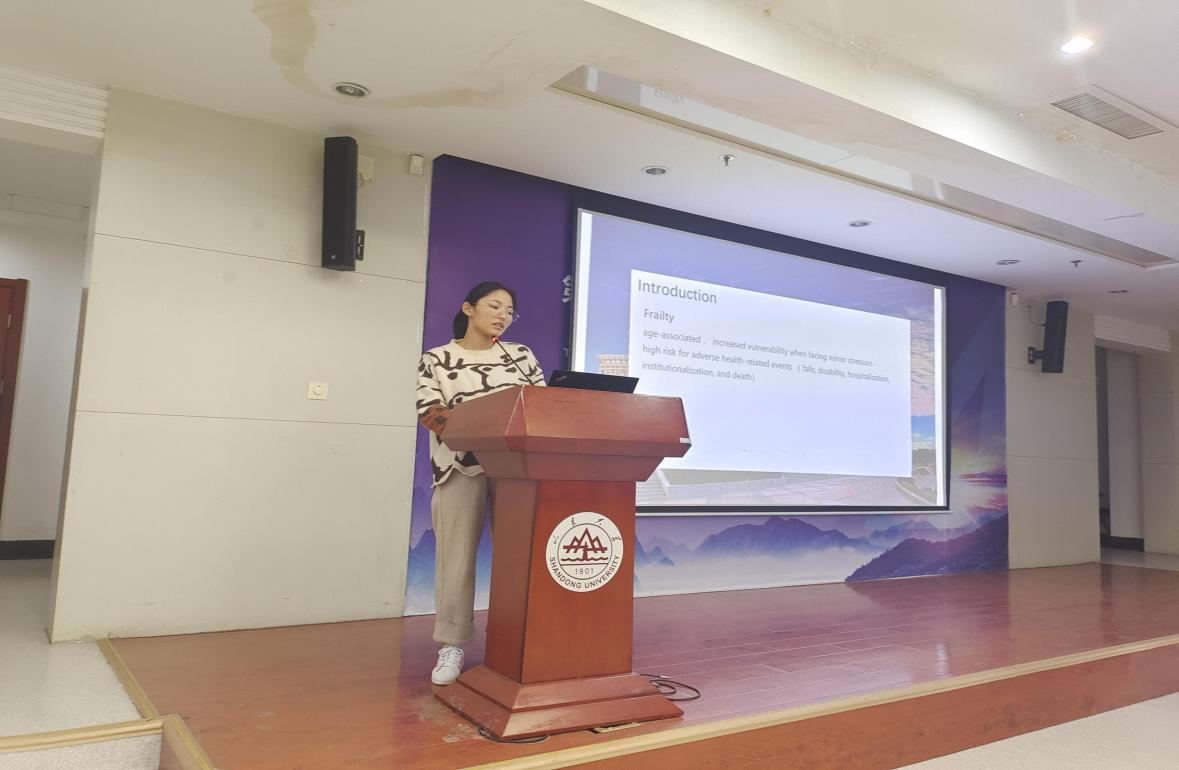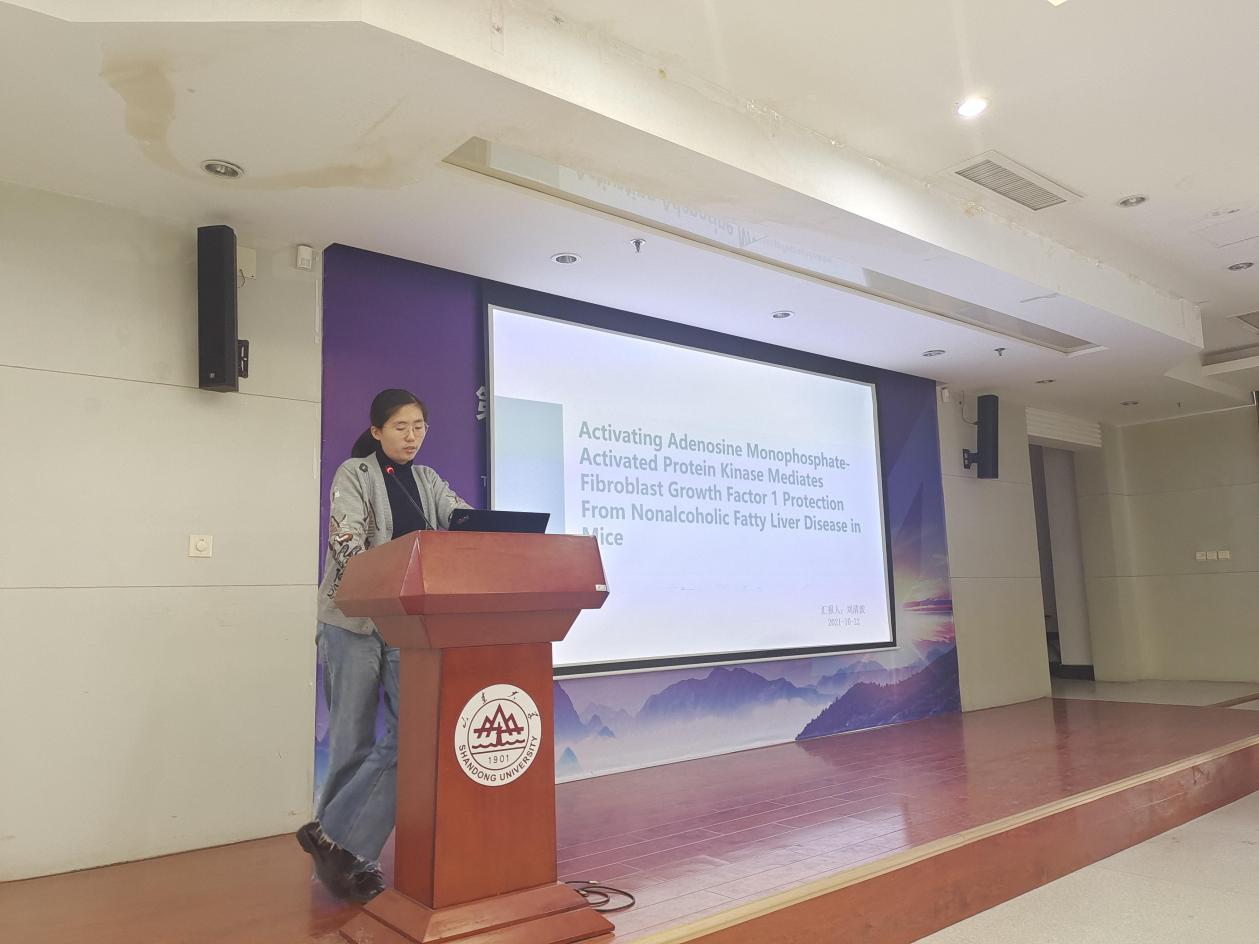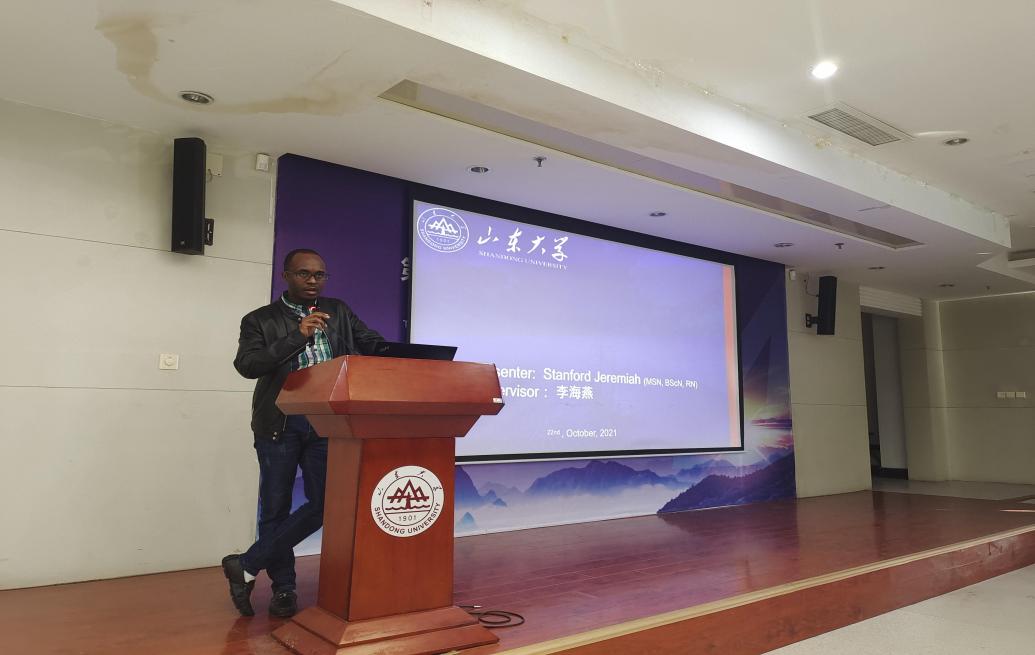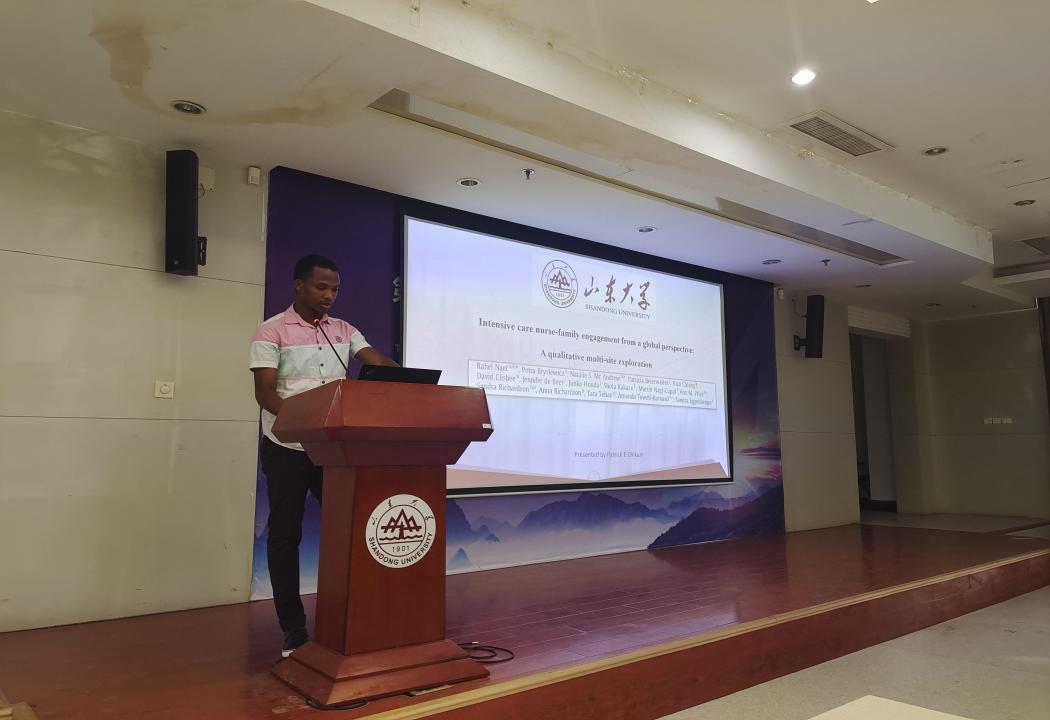2021年10月22日,山东大学护理与康复学院举行本学年第4期、总第210期学术论坛在学院105报告厅举行,本次学术论坛的汇报者为李扬、刘清波、STANFORD、PATRICK,指导老师为贾愚老师。
第一位汇报者是2020级硕士研究生李扬,本次汇报的是2019年发表在JOURNAL OF THE AMERICAN GERIATRICS SOCIETY杂志上的一篇文章,该杂志2020年影响因子是5.562,文章的题目是Effects of Multicomponent Exercise on Frailty in Long-Term Nursing Homes: A Randomized Controlled Trial。这是一项针对养老机构70岁及以上衰弱老年人进行的渐进性多元运动干预研究,该多元运动包含了5分钟热身、25分钟力量训练、10分钟平衡训练及5分钟冷身运动,每周两次,持续6个月。不进行多元运动的天数,会让老年人进行散步,6个月后的目标达到每周步行达到140分钟。使用非配对t检验、卡方检验、双向混合设计方差分析分析了组间和组内在衰弱、跌倒、死亡、入院次数等的变化。结果显示渐进性多元运动干预可以有效改善该人群的衰弱状态,降低跌倒、死亡的不良结局。但是干预结束后降低跌倒的效果消失,因此未来研究应该注重多元运动干预的持续性。

第二位汇报者是刘清波,本次汇报的文章是2021年发表于Hepatology杂志,该杂志在2020年的影响因子是17.422。她汇报的文章题目是Activating Adenosine Monophosphate-Activated Protein Kinase Mediates Fibroblast Growth Factor 1 Protection From Nonalcoholic Fatty Liver Disease in Mice,该研究主要是通过构建二型糖尿病合并非酒精性脂肪肝的小鼠模型和体外棕榈酸盐诱导的氧化应激与脂质代谢失调的HepG2细胞模型,来探索FGF1在非酒精性脂肪肝中的治疗机制。本篇研究采用了蛋白免疫印迹法、RT-PCR和免疫组织化学染色等方法,结果表明FGF1通过FGFR4介导的AMPK激活抑制脂质堆积,激活Nrf2介导的抗氧化信号通路,增强肝脏脂质代谢和抗氧化信号,从而预防代谢综合征引起的肝脂代谢紊乱和氧化应激,从而对非酒精性脂肪肝产生保护作用。

The third reporter is Stanford Jeremiah Costantine.
This report is an article published in Lancet Oncology Journal in December, 2020, entitled as Short-course radiotherapy followed by chemotherapy before total mesorectal excision (TME) versus preoperative chemoradiotherapy, TME, and optional adjuvant chemotherapy in locally advanced rectal cancer, this was conducted as randomized controlled trial, multicentred and open-label. The main target of this experimental study was to decrease the rate of disease-treatment failure and was done by comparing two selected group in oncology department of seven countries, the standard care and new treatment therapy (neoadjuvant chemotherapy) for patients with colorectal cancer.
In this multicentre, open-label, randomised, controlled, phase 3 trial, participants were recruited from 54 centres in the Netherlands, Sweden, Spain, Slovenia, Denmark, Norway, and the USA. Patients were eligible if they were aged 18 years or older, with an Eastern Cooperative Oncology Group (ECOG) performance status of 0–1, had a biopsy-proven, newly diagnosed, primary, locally advanced rectal adenocarcinoma, which was classified as high risk on pelvic MRI (with at least one of the following criteria: clinical tumour [cT] stage cT4a or cT4b, extramural vascular invasion, clinical nodal [cN] stage cN2, involved mesorectal fascia, or enlarged lateral lymph nodes), were mentally and physically fit for chemotherapy, and could be assessed for staging within 5 weeks before randomisation. Eligible participants were randomly assigned (1:1), using a management system with a randomly varying block design (each block size randomly chosen to contain two to four allocations), stratified by centre, ECOG performance status, cT stage, and cN stage, to either the experimental or standard of care group. All investigators remained masked for the primary endpoint until a prespecified number of events was reached.
Patients allocated to the experimental treatment group received short-course radiotherapy (5 Å~ 5 Gy over a maximum of 8 days) followed by six cycles of CAPOX chemotherapy (capecitabine 1000 mg/m. orally twice daily on days 1–14, oxaliplatin 130 mg/m. intravenously on day 1, and a chemotherapy-free interval between days 15–21) or nine cycles of FOLFOX4 (oxaliplatin 85 mg/m. intravenously on day 1, leucovorin [ folinic acid] 200 mg/m. intravenously on days 1 and 2, followed by bolus fluorouracil 400 mg/m. intravenously and fluorouracil 600 mg/m. intravenously for 22 h on days 1 and 2, and a chemotherapy-free interval between days 3–14) followed by total mesorectal excision. Choice of CAPOX or FOLFOX4 was per physician discretion or hospital policy. Patients allocated to the standard of care group received 28 daily fractions of 1.8 Gy up to 50.4 Gy or 25 fractions of 2.0 Gy up to 50.0 Gy (per physician discretion or hospital policy), with concomitant twice-daily oral capecitabine 825 mg/m. followed by total mesorectal excision and, if stipulated by hospital policy, adjuvant chemotherapy with eight cycles of CAPOX or 12 cycles of FOLFOX4. The primary endpoint was 3-year disease-related treatment failure, defined as the first occurrence of locoregional failure, distant metastasis, new primary colorectal tumour, or treatment-related death, assessed in the intention-to-treat population. Safety was assessed by intention to treat. This study is registered with the EudraCT, 2010-023957-12, and ClinicalTrials.gov, NCT01558921, and is now complete.
Between June 21, 2011, and June 2, 2016, 920 patients were enrolled and randomly assigned to a treatment, of whom 912 were eligible (462 in the experimental group; 450 in the standard of care group). Median follow-up was 4.6 years (IQR 3.5–5.5). At 3 years after randomisation, the cumulative probability of disease-related treatment failure was 23.7% (95% CI 19.8–27.6) in the experimental group versus 30.4% (26.1–34.6) in the standard of care group (Hazard ratio 0.75, 95% CI 0.60–0.95; p=0.019). The most common grade 3 or higher adverse event during preoperative therapy in both groups was diarrhoea (81 [18%] of 460 patients in the experimental group and 41 [9%] of 441 in the standard of care group) and neurological toxicity during adjuvant chemotherapy in the standard of care group (16 [9%] of 187 patients). Serious adverse events occurred in 177 (38%) of 460 participants in the experimental group and, in the standard of care group, in 87 (34%) of 254 patients without adjuvant chemotherapy and in 64 (34%) of 187 with adjuvant chemotherapy. Treatment-related deaths occurred in four participants in the experimental group (one cardiac arrest, one pulmonary embolism, two infectious complications) and in four participants in the standard of care group (one pulmonary embolism, one neutropenic sepsis, one aspiration, one suicide due to severe depression).
The observed decreased probability of disease-related treatment failure in the experimental group is probably indicative of the increased efficacy of preoperative chemotherapy as opposed to adjuvant chemotherapy in this setting.
Therefore, the experimental treatment can be considered as a new standard of care in high-risk locally advanced rectal cancer.
Despite the rigorous methods undergone under this study, there were some pitfalls during the course of conducting this study, and some limitations were identified as here under .
I. Alteration of the primary endpoint during a trial is undesirable but was considered necessary because disease-free survival was inappropriate in a neoadjuvant trial on patients with high-risk locally advanced rectal cancer.
II. Absence of a central review of baseline MRIs. Patients could have been under-staged or over staged, although over-staging was most probably predominant. However, bias towards one group is unlikely to have occurred because randomisation was stratified
Implications of the study from a nursing standpoint
The study showed that change in medical care model is crucial to further improve the quality of nursing care at the Department of Clinical Oncology and This study serves as a wake-up call to all nurses in the oncology department to conduct extensive research on the proper management of colorectal cancer treatment regimens, which later may contribute to improved patient quality of life.

The fourth reporter is PATRICK
Research article: Intensive care nurse-family engagement from a global perspective: A qualitative multi-site exploration. Journal: Intensive and Critical Care Nursing with journal impact factor of 3.072 reported on 2020. The author is Naef, Rahel, et al,.2021.
The research paper provides the understanding on the nurses and family engagement in critical care units as the global perspective from 10 countries, 5 continents. Engagement plays key role as the critical illness nature brings distress for the family, and often results in negative effects on family health that can influence family’s ability to support their critically ill family member.
Objectives: To describe nurses’ perceptions and practices of family engagement in adult intensive care units from a global perspective.
Design: A qualitative-descriptive multi-site design using content analysis.
Settings: The study was conducted in 26 intensive care units of 12 urban, metropolitan, academic medical centers in ten countries, spanning five continents.
Participants: A total of 65 registered nurses (77% women, age of M = 39.5, SD = 11.4 years) participated. Most held intensive care certification (72%) and had worked on average 10 (SD = 9.6) years in the ICU.
Methods: Semi-structured, individual interviews (M = 38.4 min, SD = 12.0) were held with ICU nurses at the hospital (94%) or their home using an interview guide. Qualitative interview data were analyzed using inductive content analysis.
Results: The research found that nurse-family engagement was an ebb and flow of relational power that needed to be carefully negotiated and balanced, with nurses holding and often exerting more power than families.
Constant fluctuations in nurses’ practices of engagement occurred in day-to-day practice from shift-to-shift and from nurse-to-nurse. Family engagement was dependent on individual nurses’ attitudes and perceptions of family, the patient’s condition, and workload. Lastly, family engagement was shaped by the ICU context, with team culture, collaborative relationships, unit structures and organizational resources either enabling or limiting nurses’ ability to engage with families.
Conclusions: This global study provides an in-depth understanding of the way nurses engage with families in ICU and reflects many different cultures and health systems. Research found that nurse-family engagement was marked by a shifting, yet often unequal power distribution in the nurse-family relationship, inconsistent nurse engagement practices, both of which resulted in variable family engagement in intensive care. This research contributes a detailed description of engagement as practiced in the everyday delivery of health care. A more concentrated team effort, based on a shared culture and defined framework of family care is needed to ensure that families of critically ill persons are fully engaged in all aspects of intensive care.

四位汇报者对相关学科领域的研究进行了精彩汇报,贾愚老师根据汇报内容进行了精彩点评,提出了许多宝贵的建议,大家受益匪浅,这一期学术论坛圆满结束。